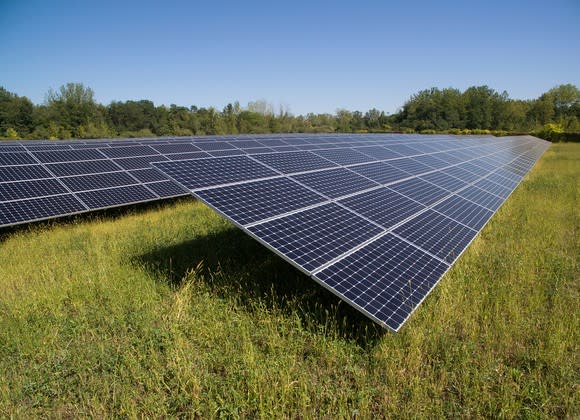Why SunPower Is Killing Its Biggest Business
Two years ago, nearly half of SunPower Corporation's (NASDAQ: SPWR) business was in solar power plants where the company did everything from buying land to signing contracts with utilities and even making the solar panels. But the power-plant business has become so competitive that SunPower has decided to shut down most of its operations.
Instead, SunPower is returning its focus to high-efficiency solar panels and distributed-solar markets -- which means solutions for residential and commercial rooftops. The move is dramatic but may be the company's best option long term.

Image source: SunPower.
How big power plants were for SunPower
In 2016, power plants accounted for 54.8% of SunPower's $2.56 billion in revenue, but profits were hard to come by, generating a gross margin of just 5.3%. In 2017, power plants were down to 42.1% of $1.87 billion in revenue and a gross margin of negative 9.2%. That's when management decided power plants weren't worth the effort, turning their focus to commercial and residential markets that show more promise. In the second quarter of 2018, for example, residential solar sales grew 31.7% versus a year ago to $205.2 million and generated a 21.8% gross margin while commercial sales grew 26% to $133.3 million and generated a 6% gross margin. Both margin levels are expected to improve as new products hit the market over the next few yeard.
On the second-quarter 2018 conference call, CEO Tom Werner said SunPower will focus only on providing solutions based on its P-Series solar panel being manufactured at a joint venture in China. This is a component-supply model as opposed to the company taking on most of the development risk as it had done in the past. "Given this market dynamic, we decided to exit Power Plant Development and will be addressing this market exclusively via an Equipment Supply model centered around P-Series product from our DZS joint venture," said Werner.
Pricing pressure on power plants has been too much to handle for SunPower, and it sees better opportunities elsewhere.
Transitioning products to distributed solar
Even the company's plans within existing manufacturing have changed in the last two years. When SunPower announced intentions to build up to 5 gigawatts (GW) of P-Series (solar panels based on assembling commodity solar cells rather than using high-efficiency proprietary solar panels called X-Series), production in China was supposed to be a way to stay attached to the power-plant business. But even those plans have changed over time.
SunPower is seeing that P-Series' efficiency, which is slightly higher than commodity solar panels, works well in distributed-generation markets, where solar panel prices are slightly higher than power plants. The product fills a lower cost need for some customers who don't value SunPower's premium-priced products, keeping the company competitive with commodity competitors. Even for the price concious, P-Series can command a small premium over commodity solar panels in these markets, so SunPower can transition some P-Series sales from power plants to distributed-generation markets where SunPower can leverage a larger customer base.
P-Series won't be entirely giving up on power plants, but even this product, which is built for power plants, is finding a home in distributed generation for SunPower, which is where the company's focusing developments and manufacturing like X-Series and a next-generation solar panel. Management hopes this the wider breadth of price points will help the company expand its market further.
Betting big on distributed solar
If SunPower is going to succeed long term, it's going to have to do so in distributed solar. Power plants have proved to be too competitive both from the development side and from solar-panel manufacturer side for a premium supplier to make money.
As the power-plant business is de-emphasized, SunPower hopes to increase volume sales into distributed solar markets for all of its products. If the company can generate strong margins, it'll be the right move, but it's a big risk given the revenue SunPower has generated from the power plant business over the past decade.
More From The Motley Fool
Travis Hoium owns shares of SunPower. The Motley Fool has no position in any of the stocks mentioned. The Motley Fool has a disclosure policy.
